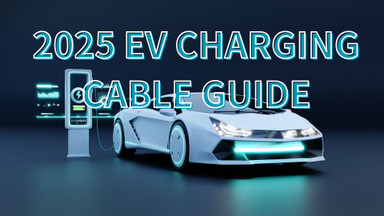Posted by BNTECHGO on 8th May 2025
2025 EV Charging Cable Guide: Choosing FEP Signal Wire, Silicone Wire, and Power Cable
Explore the mainstream EV (electric vehicle) charging cable types for 2025—from durable main power cables to flexible silicone wires and stable FEP signal lines. Learn how to choose the right cable for every application.
As electric vehicles become more widespread, the performance and reliability of charging cables are more critical than ever. Whether you're designing public charging stations or setting up home charging units, selecting the right cable type is the key to ensuring long-term safety and efficient operation. In this article, we break down the three essential cable types for 2025 EV charging infrastructure, helping you make informed and confident choices.
According to a report by Grand View Research , the U.S. EV charging infrastructure market is expected to grow at a compound annual growth rate (CAGR) of 30.3% starting in 2025, reaching USD 24.07 billion by 2030. With the continued expansion of outdoor fast-charging stations and home charging setups, cable requirements now go far beyond basic conductivity. Modern cables must meet stringent standards for tensile strength, abrasion resistance, flame retardancy, and weather durability.
1. EV Main Power Cables
Typical Structure:
- Stranded Copper (or Aluminum) Conductors: Excellent current-carrying capacity
- XLPE or EPR Insulation: High voltage resistance with low dielectric loss
- Aramid Fiber or Fiberglass Reinforcement: Boosts tensile strength and resists mechanical stress
- Metal Braid or Foil Shielding: Minimizes electromagnetic interference (EMI) for added safety
TPE, EPDM, or Neoprene Outer Jacket: Oil-resistant, UV-resistant, flame-retardant, and highly weatherproof
Key Advantages:
- Stable performance under high-voltage, high-current conditions
- Exceptional mechanical strength and anti-aging properties
- Superior flame retardancy and environmental adaptability
Typical Applications:
- 7kW AC slow-charging feeder lines
- 50kW+ DC fast-charging main cables, including liquid-cooled types
2. FEP Teflon Signal Wires
Key Advantages:
- Outstanding chemical resistance against acids, alkalis, oils, and solvents
- Ultra-wide temperature range (–65°C to +200 °C), reliable in extreme environments
- Extremely low dielectric loss, ensuring stable, high-fidelity signal transmission
Typical Applications:
- Sensor wiring and control module connections within charging stations
- PLC control circuits and data communication lines in EV charging systems
3. Silicone Flexible Wires
Key Advantages:
- Ultra-flexible, easy to bend with minimal rebound, ideal for tight spaces
- Wide temperature range (–60 °C to +200 °C), perfect for cold or high-heat environments
- Good oil, chemical, and environmental wear resistance
Typical Applications:
- Short-distance low-voltage DC connections onboard EVs (<32A, <1 meter)
- Flexible connections for slow charging in garages or sheltered areas, especially in cold climates
Selection Tips
- Main Power Cables: Choose multi-layer composite cables with rubber or thermoplastic outer jackets for maximum durability and safety.
- Internal Signal Wiring: Use FEP Teflon-insulated wires to ensure stable control and data transmission in complex environments.
- Internal Low-Voltage Short-Distance Wiring: If flexibility and bend fatigue resistance are top priorities, silicone flexible wires are highly recommended.
Choosing EV charging cables isn't just about wire gauge—it's about matching the right materials to the specific application. At BNTECHGO, we offer high-quality FEP signal wires and silicone wires that meet stringent standards for durability, flexibility, and safety.
Explore our complete product range at https://bntechgo.com, or contact us at support@bntechgo.com to discuss the best cable solutions for your project. Follow us on YouTube, Facebook, TikTok, LinkedIn, and Instagram—we look forward to connecting with you!
If you wish to repost this article, please credit the source.






